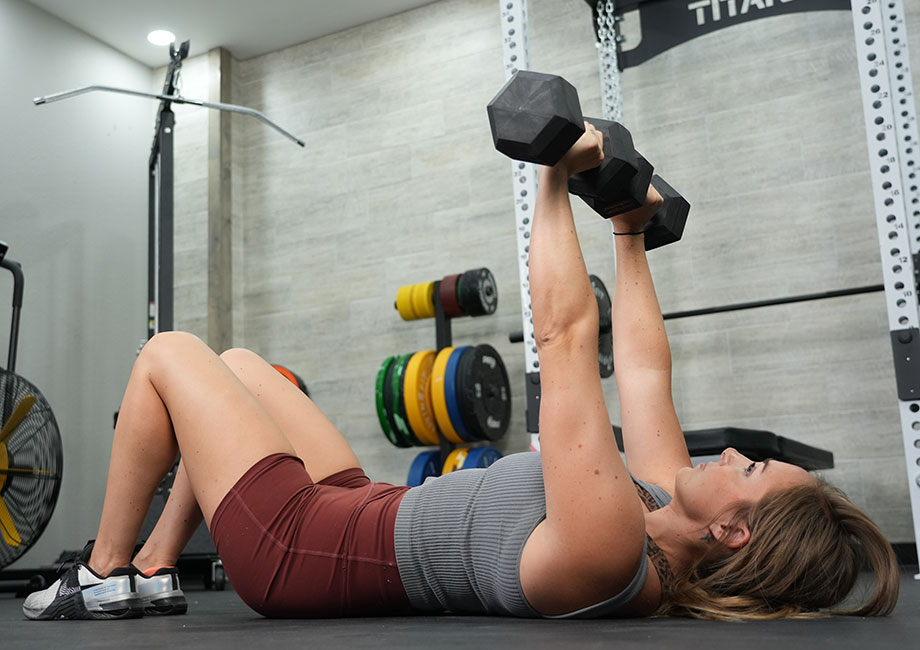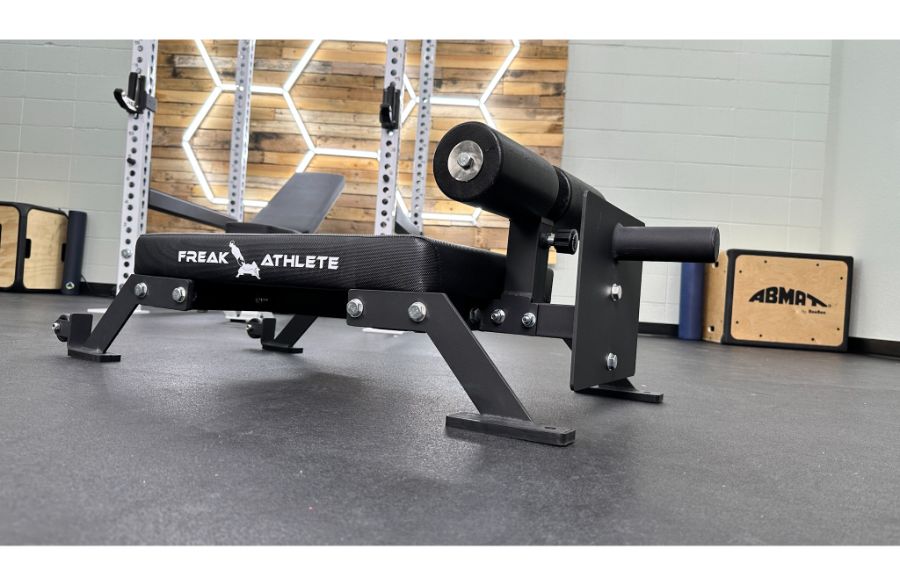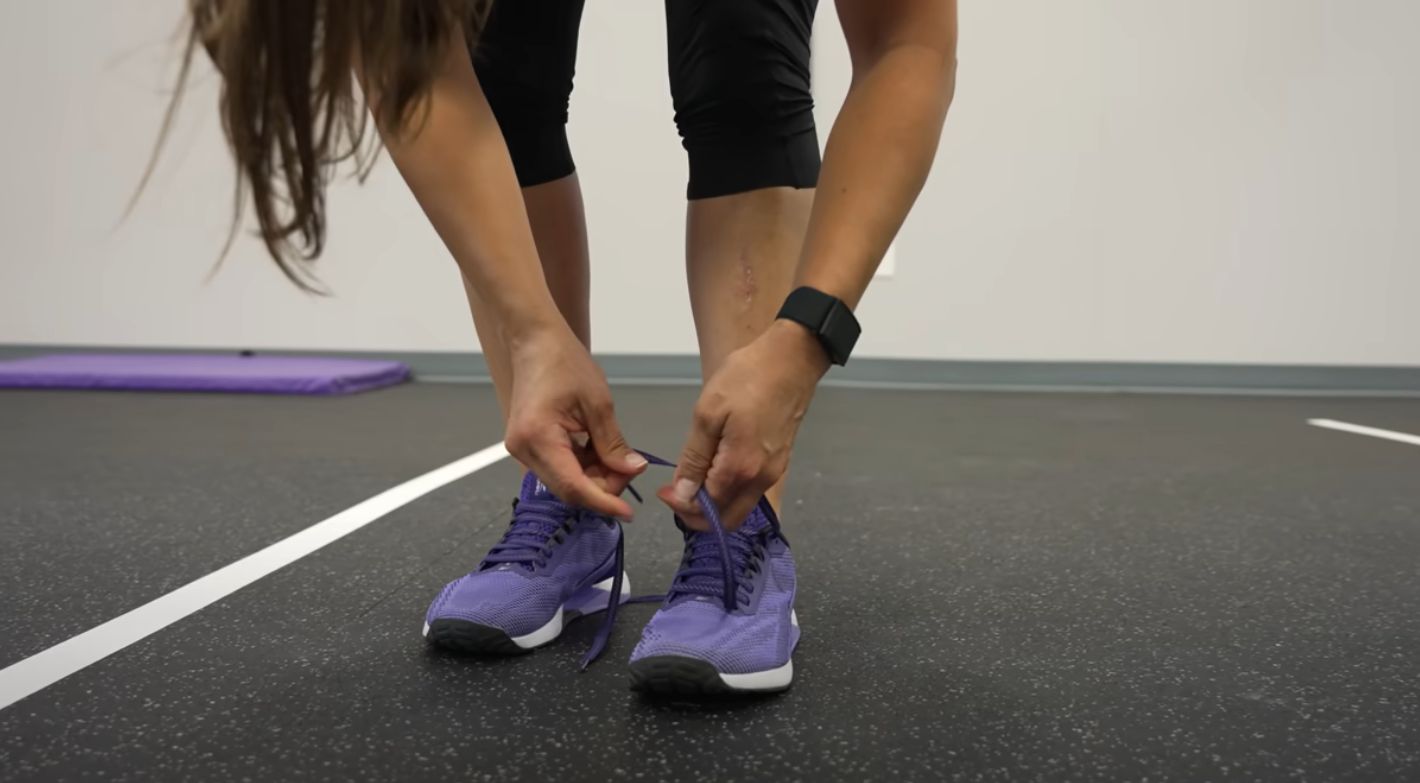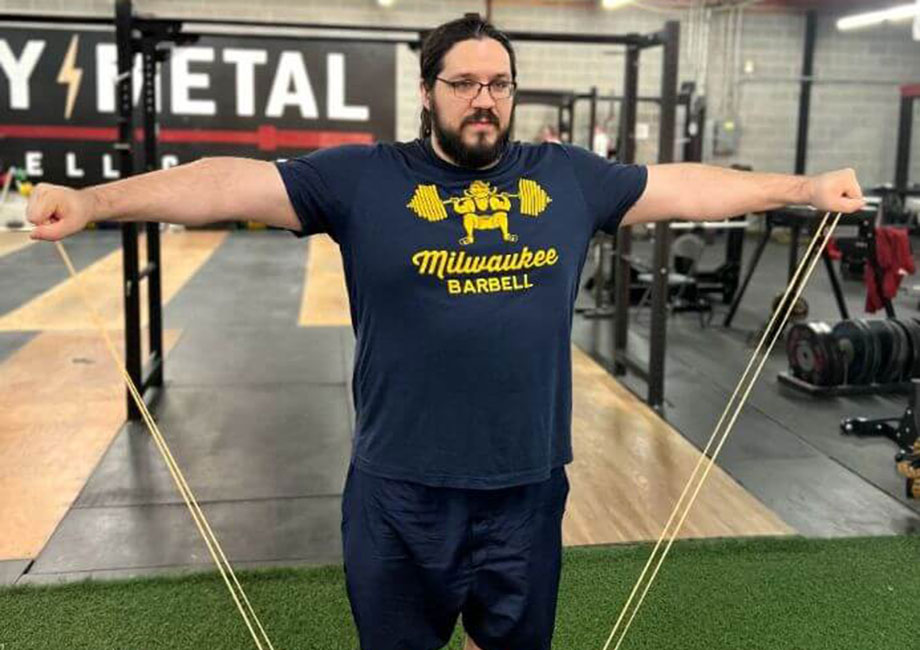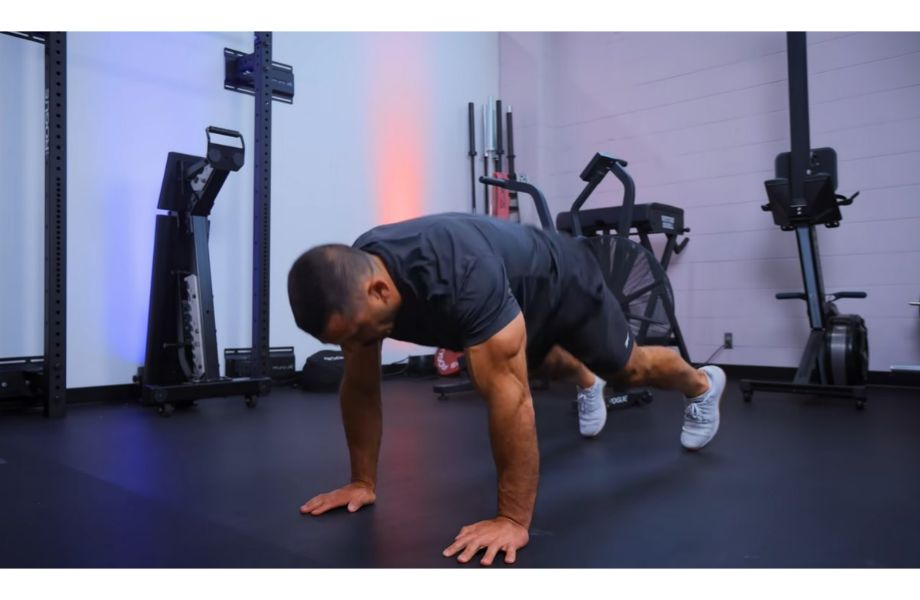Regardless of your fitness goals—weight loss, build muscle, gain strength—there are a number of exercises that should not be overlooked. Lucky for you, I’m a certified personal trainer with a knack (and passion) for working with beginner lifters, and I’m going to detail some of the best exercises for satisfying at-home workouts.
All 10 exercises I’ve selected can be performed with minimal equipment. In fact, a pair of the best adjustable dumbbells and a selection of resistance bands will be all you need for successful weight lifting at home. Plus, pretty much every exercise below can be modified: You can perform them with just your bodyweight or resistance bands or eventually progress to heavier lifts with a barbell.
RELATED: Best Resistance Bands
Weight Lifting at Home: What to Expect
The exercises I’ve outlined below include some of the most fundamental training patterns: squatting, hinging, pushing, and pulling. As a certified personal trainer, I can honestly say if you can master the exercises on my list, you’ll be stronger than ever and in a good place to branch out and challenge yourself with new exercises.

You can think of these at-home weight lifting exercises as the meat and potatoes of a promising strength training program. Most of these movements are considered compound exercises, meaning there’s more than one joint moving (compared to isolation exercises, like biceps curls, where a single joint is activated).
RELATED: 7 Dumbbell Curl Variations
Before you get started, you’ll need the following:
- Dumbbells, adjustable dumbbells, or kettlebells
- A plyo box or weight bench (for step-ups and one-arm rows)
- Floor space and an exercise mat (for floor press)
If you don’t already have this equipment handy, GGR has several recommendations for the top products for all goals and budgets.
Lower Body Exercises
First, I’ll outline the fundamentals of training the lower body muscle groups, which mainly includes your hamstrings (back of your legs) and quads (front of your legs). You can expect the following exercises to be covered in step-by-step detail:
- Goblet squat
- Reverse lunge
- Dumbbell deadlift
- Step-up
- Good morning
Goblet Squat
Why do it: Including squats in your workout plan is essential for overall leg strength, mobility, and functionality. Mastering the squat in your home gym ensures you’ll have enough strength to squat down to play with your kids, garden, or pick up a heavy package. The goblet squat in particular is easy to perform at home with whatever weight you have: dumbbells, kettlebells, or a weight plate.
How to do it:
- Start in a standing position with your feet about hip-width apart, holding a dumbbell close to your chest.Brace your core and keep your back straight.
- Initiate the squat by bending at the knees and hips.
- Lower your body and push your knees outward, making sure your knees don’t rotate or collapse inward.
- Continue descending until your quads (thighs) are parallel with the floor.
- From the bottom position of the squat, generate force into the floor with your feet, flexing your quad and glute muscles to slowly stand back up.
- Pause at the top and repeat for reps.
RELATED: How to Back Squat
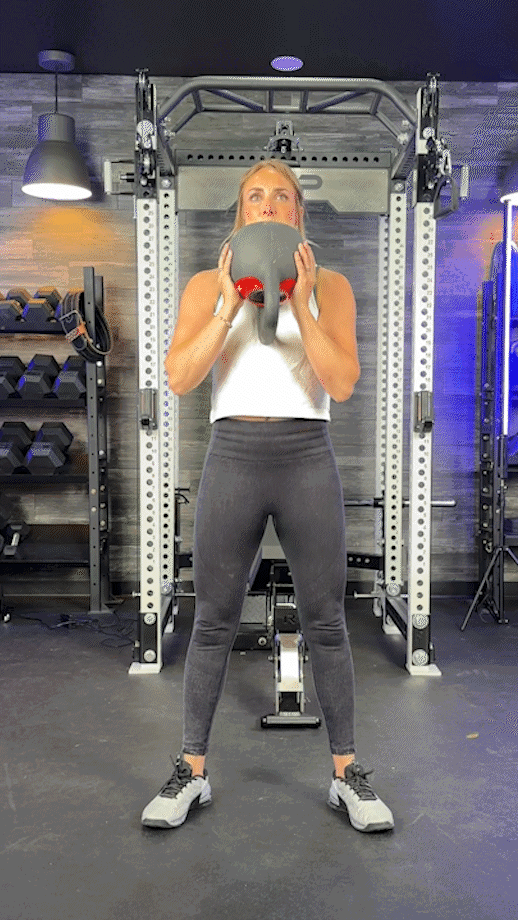
Reverse Lunge
Why do it: Lunges, much like squats, are functional to many activities you may enjoy. What’s different about a lunge is the fact it works one leg at a time. Humans are not perfectly balanced, so it’s important to include unilateral (single-leg or single-arm) exercises in any full-body workout plan. Plus, a reverse lunge puts a little less stain on the knee than a traditional forward lunge, which is great if you have achy knees!
How to do it:
- Start in a standing position with your feet hip-width apart. Start without weight until you get the hang of the movement.
- Begin the lunge by keeping one foot planted and stepping backward with your opposite foot.
- With your torso upright, bend your front leg and lower your body until both legs come to a 90-degree angle.
- Once you reach 90-degrees (the full range of motion), press into your front foot and flex your quad to stand back up, with both feet under your hips.
- Repeat all reps on one side before starting reps on the opposite side.
RELATED: Guide to Lunge Exercises
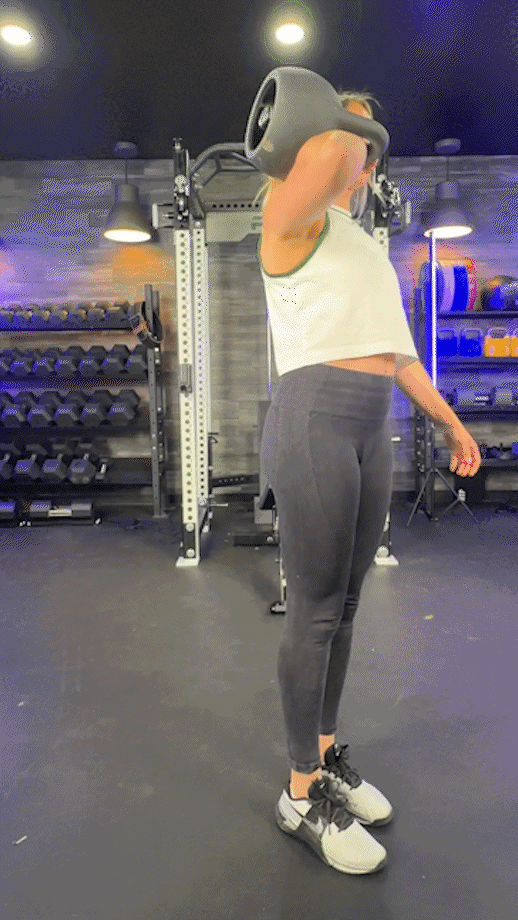
Dumbbell Romanian Deadlift
Why do it: The Romanian deadlift is the ultimate posterior chain strengthening tool. It targets muscles in your upper back, lower back, glutes, hamstrings, core, and calves. It’s a total-body move and an ideal exercise to strengthen your lower back and relieve strain from sitting at a desk.
How to do it:
- Start in a standing position, with your feet, hips, and shoulders in alignment.
- Hold a pair of dumbbells with your palms facing your legs, arms straight, and dumbbells touching your thighs.
- Pinch your shoulder blades back and down and tighten your core. You’ll need to maintain this upper back position the entire time.
- Start hinging (or pushing) your hips back with a slight bend in your knees (you should feel this in your hamstrings, big time).
- Lower as much as you can while keeping your back tight and straight (no rounding).
- At the bottom of the deadlift, tighten your glute muscles to reverse the hinge and stand back up.
- At the top of the motion, squeeze your glutes and repeat for reps.
RELATED: Romanian Deadlift Workout
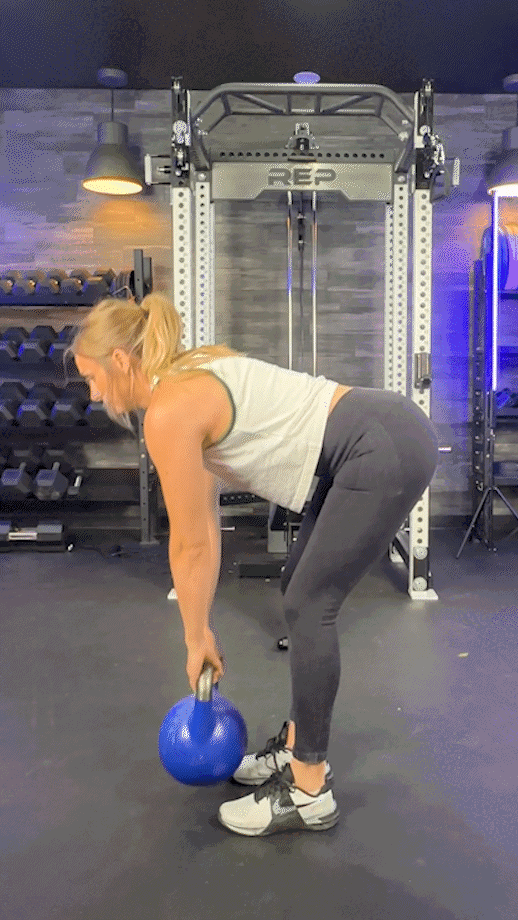
Step-Up
Why do it: Step ups are an excellent way to increase strength in your legs and work on any left-to-right imbalances. You’ll also get the chance to work on your balance and core strength, too.
How to do it:
- Stand in front of a plyo box or bench (on level ground).
- Place your left foot on the box so your front leg is at a 90-degree angle.
- Pressing into your left foot, using the strength of your quad and hamstring to drive your hips upward and stand on top of the box (without too much help from your right foot).
- Then, lower your right foot down all the way to the ground, followed by your left foot.
- Repeat with the opposite leg leading on the box.
RELATED: Best Plyo Boxes
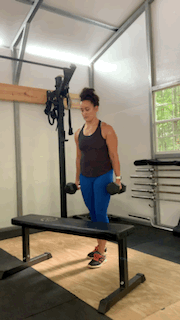
Good Morning
Why do it: The good morning is another hip hinge exercise variation, where the weight is positioned either close to your chest (with a free weight) or on your back (with a barbell). Much like the deadlift, this is an excellent tool for full-body strengthening, especially your backside, including the upper and lower back, hamstrings, and core.
How to do it:
- Start by standing with your feet shoulder-width apart, holding a dumbbell close to your chest.
- Position your upper back with your shoulders blades pinched and down away from your ears.
- With a slight bend in your knees, hinge at your hips, pushing your butt back until your chest becomes almost parallel to the floor.
- Using the strength of your core and glutes, stand back up straight and squeeze your butt to bring your hips into full extension.
- Repeat for reps.
RELATED: 17 Lower Back Exercises
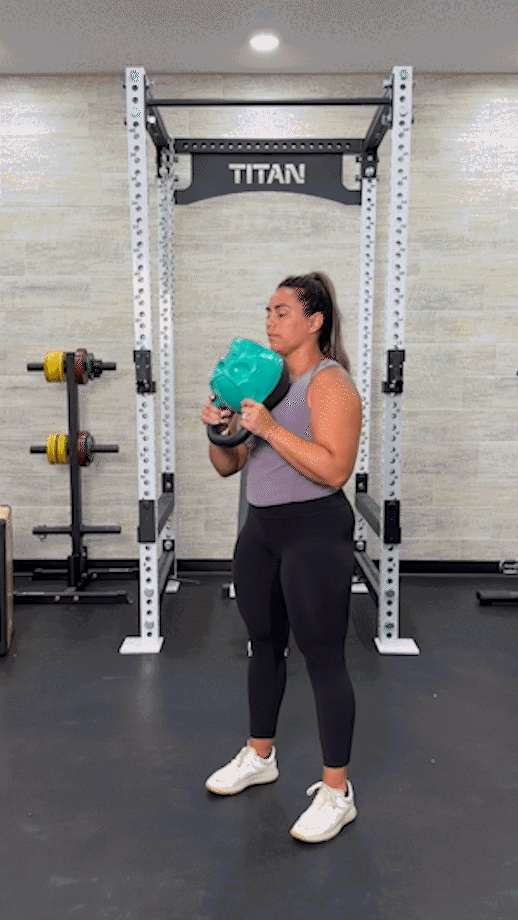
Upper Body Exercises
Now that you know some of the most basic and fundamental lower body exercises, I’ll do the same for upper body movements. You can expect a proper form breakdown for the following exercises:
- Standing overhead press
- Floor press
- Renegade row
- Farmer’s carry
- Single-arm dumbbell row
Standing Overhead Press
Why do it: The overhead press, when done correctly, is an ideal way to gain muscle and strength while training your shoulders to stay put inside the shoulder girdle. It also helps you train your muscle control so you can press over your shoulders without hurting yourself doing everyday tasks like yard work or playing with your kids.
How to do it:
- Holding a dumbbell in each hand, stand with your feet about shoulder-width apart.
- Bring your dumbbells up past shoulder height so that both arms make a 90-degree angle and your palms are facing forward.
- Brace your core and make sure your shoulders are plugged into the shoulder girdle away from your ears (not shrugged up). Maintain this posture through the entire set.
- With the shoulder girdle stable, push the dumbbells upward toward the ceiling until your elbows are locked out.
- Lower the dumbbells with control back down to shoulder height and repeat for reps.
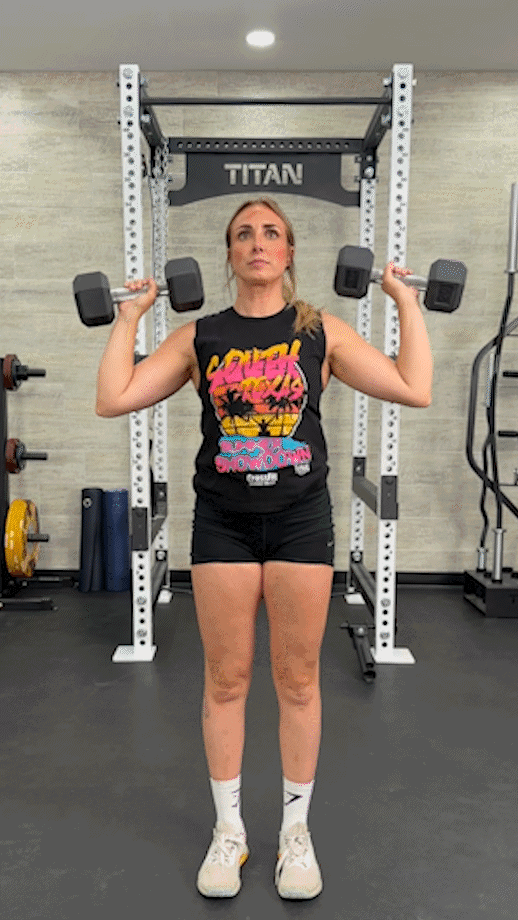
Floor Press
Why do it: The floor press exercise helps strengthen your chest and upper body and is easy to do without an elaborate gym set up. And if you have one of the best weight benches in your home gym, the floor press is a way to switch up your routine.
How to do it:
- On an exercise mat or pad, being in a seated position on the floor, a pair of dumbbells at your sides, and legs extended straight.
- With a dumbbell in each hand, rest the weights on your legs and roll on to your back.
- Lying flat, position your elbows on the floor and arms at 90-degrees.
- Adjust your upper back to pinch your shoulders blades together so that your chest rises slightly. Keep the shoulder girdle locked in place during the entire set.
- Press the dumbbells toward the ceiling until your arms are straight.
- With control, lower your arms until your elbows reach the floor.
- Repeat for reps.
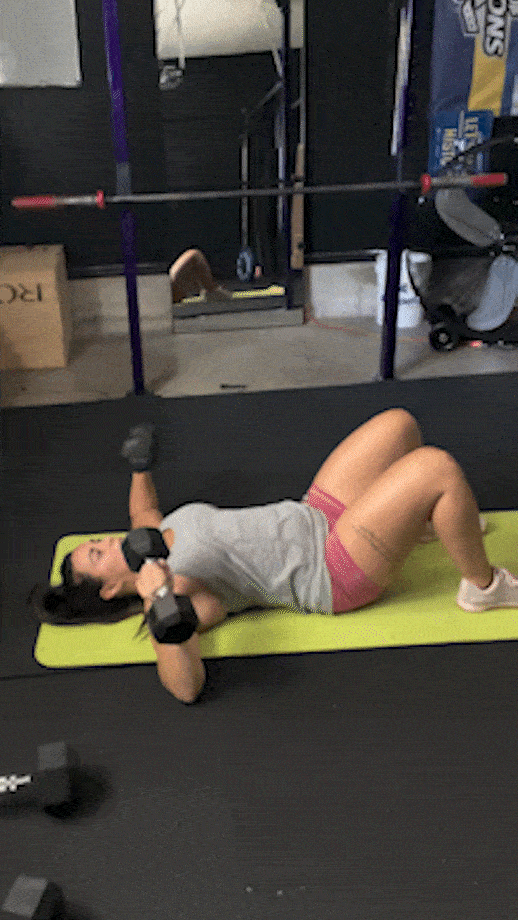
RELATED: What Muscles Does The Bench Press Work?
Renegade Row
Why do it: It’s a plank and a row, what’s not to love? And you’re going to try not to wobble around or lift your hips, so it’s a whole lot of core and stabilization. That’s why you should do it!
How to do it:
- Start by placing a pair of hex-style dumbbells on the floor about shoulder-width apart.
- Get down on the floor and wrap your hands around the dumbbells.
- Keeping the dumbbells on the floor, kick your legs out straight and position them a bit wider than hipwidth apart.
- Position your arms so that your shoulders are stacked directly over your elbows and wrists. This is your starting position and should feel similar to the top of a push-up.
- Tighten your glutes and core to prevent rotation.
- Pull the left dumbbell into a row toward your right hip by squeezing your shoulder blades together.
- Lower the dumbbell with control back to the floor and repeat the row on the other side.
RELATED: Anti-Rotation Core Exercises
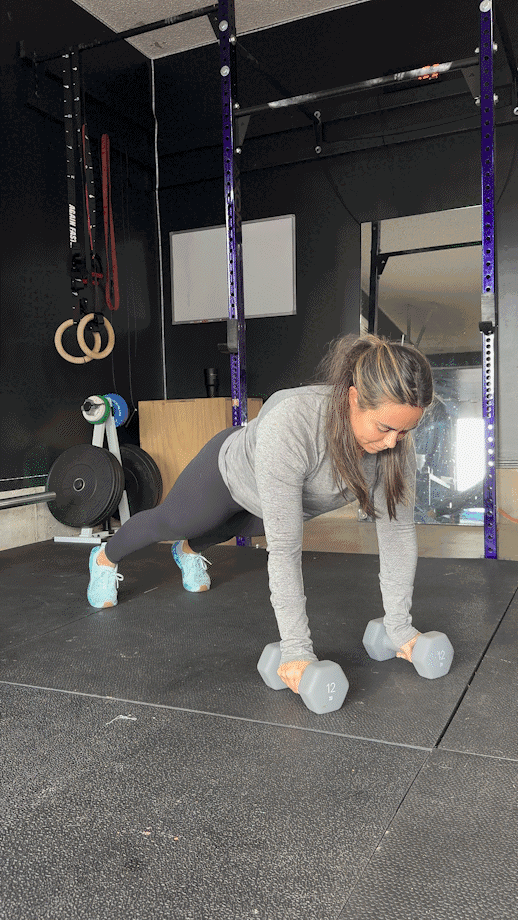
Farmer’s Carry
Why do it: The farmer’s carry is so simple, yet so effective. You’re going to work your grip strength, upper back, arms, core, and even legs. This exercise also comes in handy when you’re on a mission to bring all the groceries in from the car in one single trip.
How to do it:
- Select a pair of moderate to heavy dumbbells. In a standing position with your arms straight and at your sides, hold a dumbbell in each hand.
- Position your shoulders blades down and back and squeeze your shoulders blades together without bending at the elbow.
- Keeping shoulders down away from your ears, starting walking forward in a straight line.
- Walk for desired length or time.
- Turn around and use the same route if needed.
RELATED: Farmer’s Walk Benefits
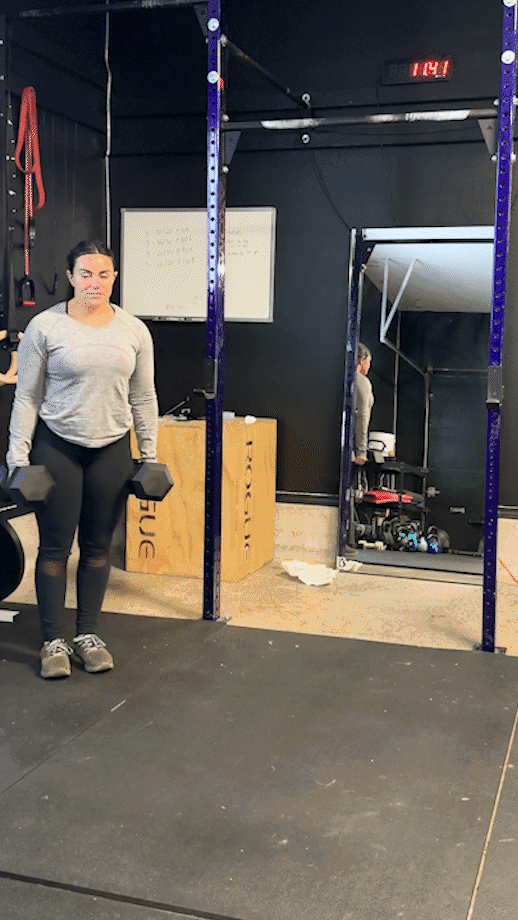
One-Arm Dumbbell Row
Why do it: The one-arm dumbbell row is essential to master if you want to build a strong back. One-arm rows may help you stabilize your shoulders, improve your posture, and aid with stronger deadlifts and squats. It’s also an excellent way to settle left-to-right imbalances.
How to do it:
- Using a weight bench (or plyo box) place your left knee and left hand on the flat surface.
- Place your right foot on the floor and use your right leg as a kickstand to help you stabilize your left side.
- Grab a dumbbell with your right hand, palm facing inward.Your back should be neutral (not rounding or arching), eyes slightly forward.
- With your shoulder blades pinched together (down and away from your ears) use the strength from the right side of your back (under your armpit) to bend at the elbow and pull the dumbbell toward your hip.
- Pause at the top for one second before lowering the dumbbell until your elbow extends fully.
- Repeat for reps.
RELATED: Bent-Over Row Alternative
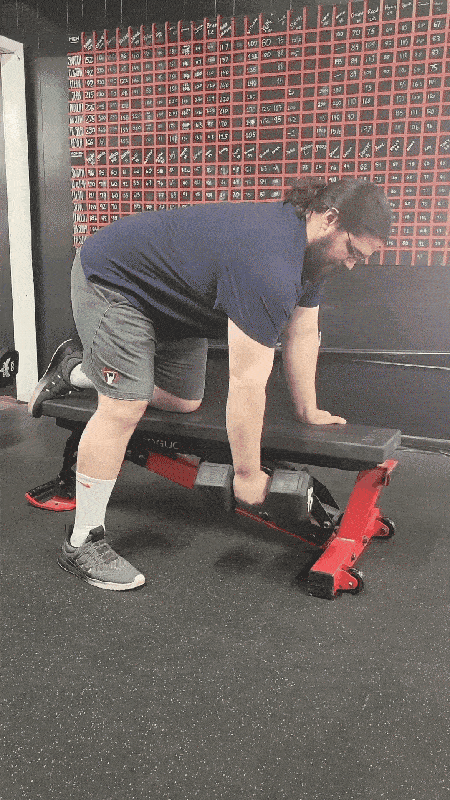
Even More Resources for Weight Training at Home
Your friends here at Garage Gym Reviews (including myself) are certified personal trainers, CrossFit Level 1 Trainers, Olympic-level athletes, and gym owners. We’ve created tons of workouts for you to do at-home and have in-depth explanations on everything from the bent-over row to the bench press.
More workout resources:
More exercise guides:
- How to: Turkish get-up
- How to: Close-grip bench press
- How to: Pallof press
- How to: Bulgarian split squat
Weight Lifting at Home: FAQs
Can you effectively lift weights at home?
Yes! At home, using free weights, you can build (or follow) an effective resistance training program. Using the principles of progressive overload, you can adapt your routine with heavier weights, more repetitions, less repetitions (with heavier weights), more sets, increase (or decrease) range of motion, shorten rest time, or choose more difficult variations of any given exercise.
RELATED: Home Gym Essentials
How can I practice weight lifting at home?
You can, indeed, practice weight lifting at home. And you may even be surprised just how much you can accomplish with a set of adjustable dumbbells. If you’re new to working out at home or you’re building a home gym from scratch, start small. A few solid investments can go a long way. We’ve also curated a list of the best budget home gym equipment so you can plan for everything you may want or need.
What weight should a beginner lift?
Speaking as a certified personal trainer, everyone has a different baseline when it comes to strength. Many people will need to begin with bodyweight exercises (like squats, lunges, and push-ups) to gain enough strength to perform the exercise properly with load.
However, some folks will be able to perform exercises with 30 to 50% of their own body weight on day one. For this reason, having a set of dumbbells or an adjustable dumbbell set will help you progress your strength rather than plateauing with only one or two weight options.


